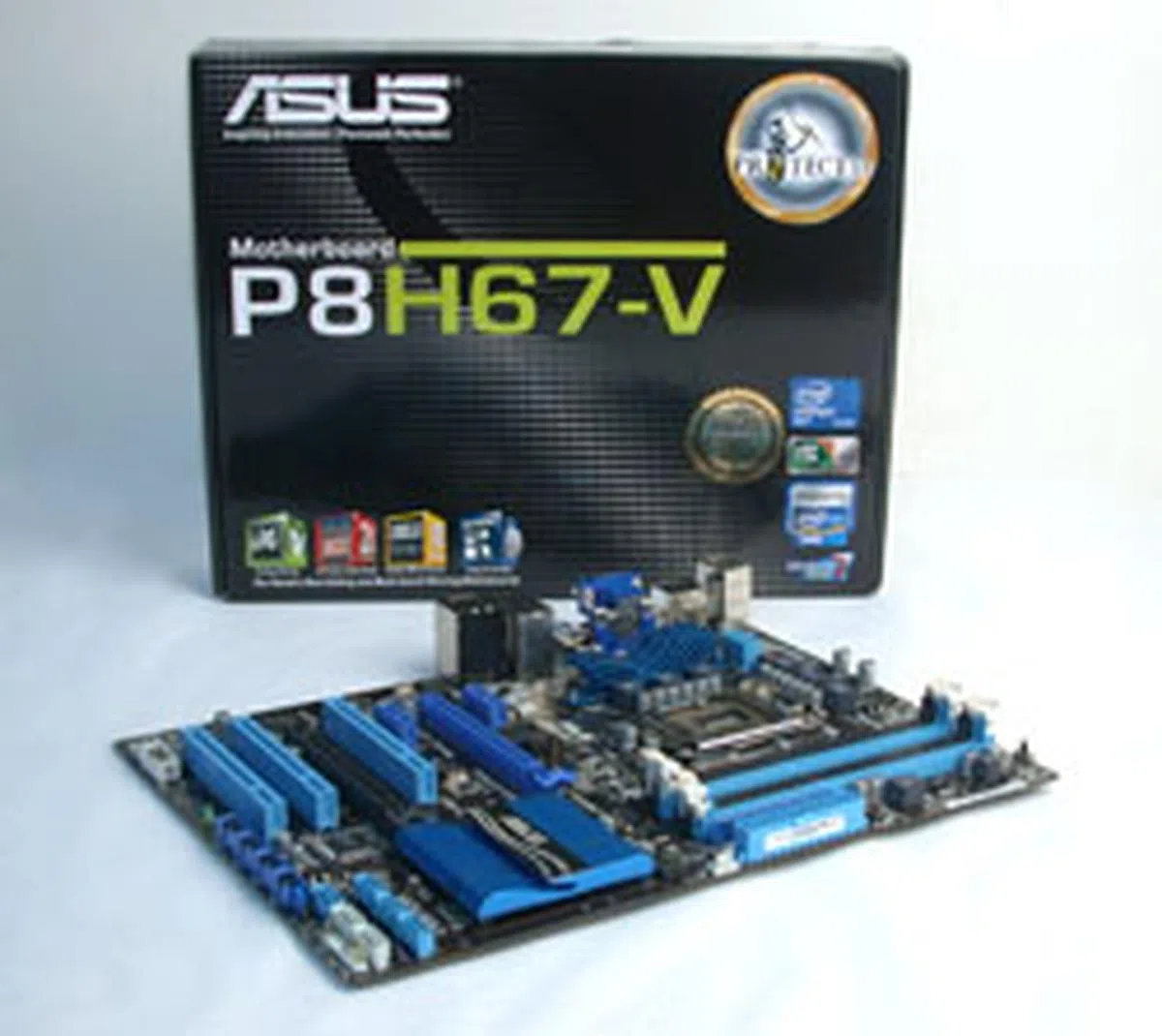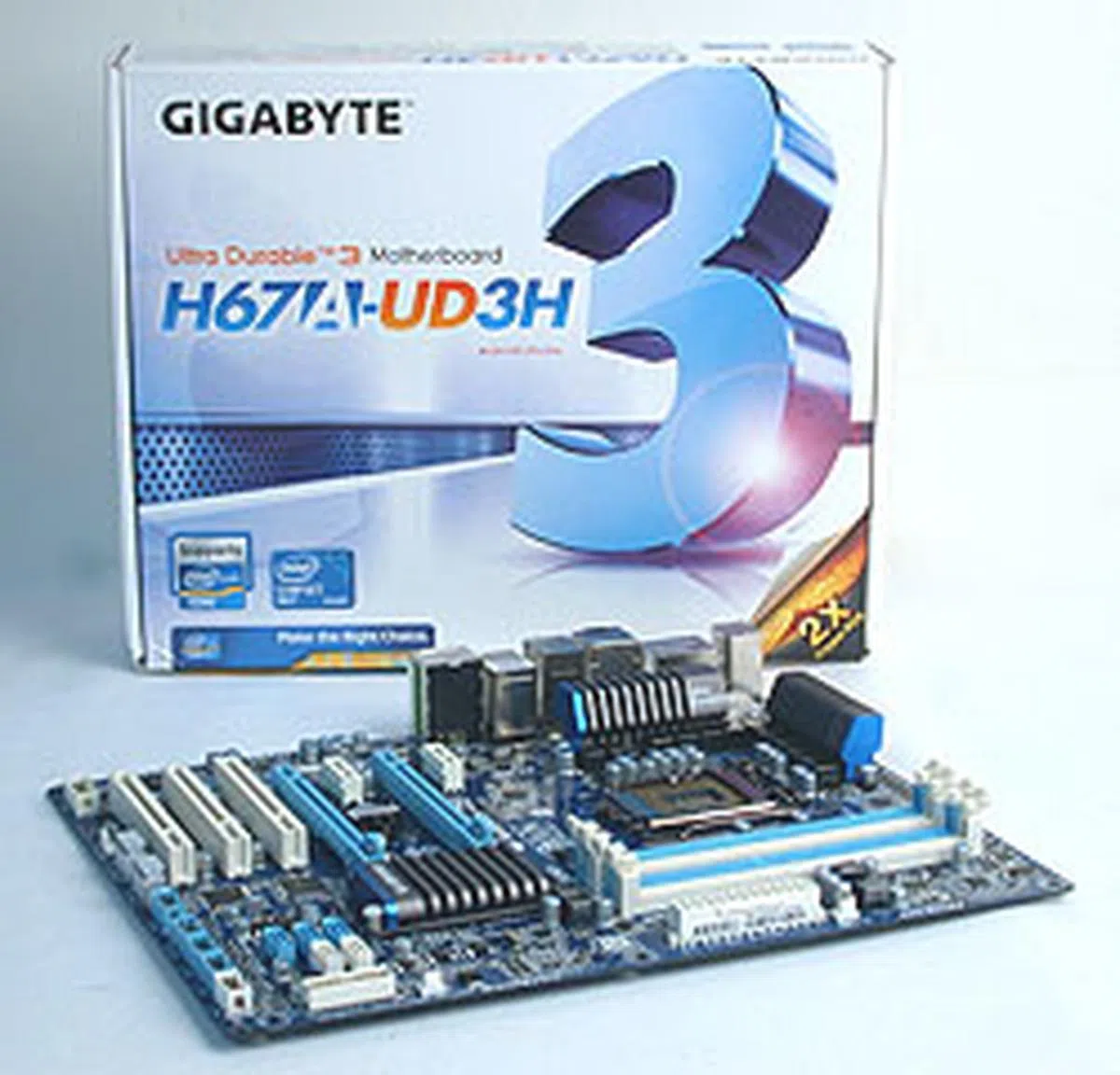Intel H67 Motherboard Roundup - Four of a Kind
Yes, we know all about the glitch affecting Intel's 6 series chipsets for Sandy Bridge processors. It's disappointing to have to wait for the newer, revised motherboards, but that just means more time to do proper research. To help you pick your next mainstream H67 motherboard, here's our small roundup.
That Sandy Bridge Glitch
By now, the issue with Intel's 6-series chipsets has been widely reported. This glitch potentially affected the four standard SATA 3Gbps ports on these chipsets, leading to performance degradation and even possible data loss.
The chip giant promptly of the affected motherboards and has started producing new bug-free silicon. Early adopters who have bought motherboards to accompany their new Sandy Bridge processors can exchange their faulty boards with their respective board manufacturers (check here for local users). However, while some vendors like , , and , have announced their revised, 'B3 stepping' versions, we're still awaiting word from the rest. Intel has said publicly that it expects full production in April, so stocks of these B3 boards could be limited now.
If you haven't paid for your Sandy Bridge system yet, you can count yourself fortunate that you have avoided the hassle of replacing the board. And unless you're dead sure that you won't ever be using those SATA 3Gbps ports, we highly recommend that you wait for the revised boards. ASUS, for instance, have revealed to us that they also took the opportunity to further tune the BIOS with some minor enhancements. Of course, you could take the downtime to check out which motherboard and processor best fit your needs.
After our , we are going down the performance level and looking at motherboards that use Intel's H67 Express chipset. The H67 chipset is for those who intend to use the integrated Intel HD Graphics on the Sandy Bridge processor. It also lacks many of the overclocking and tweaking options that are present on the P67 chipset, which drastically reduces the appeal of an unlocked 'K' processor for this chipset. These boards are not the new B3 versions, but we don't expect any performance discrepancies, especially since we are using the SATA 6Gbps port in our testing. Also, the tested boards are identical to the upcoming revised B3 edition boards, hence our evaluation will still be applicable to the replacement editions bearing the "B3" naming scheme.

In case you need to refresh your memory, here's what you'll get on the Intel H67 Express chipset.
With four H67 motherboards in this roundup (ASUS P8H67-V, ECS H67H2-M, Gigabyte GA-H67A-UD3H and Intel DH67BL), including both microATX and full ATX designs, there's something for everyone. So let's jump straight to the first board, the ASUS P8H67-V.
ASUS P8H67-V
Our first contender in the H67 field is the ASUS P8H67-V, which comes in the standard ATX form factor. It means plenty of board space for ASUS to be creative with their features and layout. Hence, we find some extras, like ASUS' MemOK! technology and GPU Boost, both of which can be activated through hardware switches onboard.
What was a bit of a surprise is that ASUS has included an VIA PATA controller for your older storage devices. It's certainly something that one don't find too often nowadays, but perhaps ASUS had a little too much PCB space to work with.
The ATX form factor also means that multi-GPU setups are supported, but only AMD's CrossFireX (up to quad GPUs) is certified. The first PCIe x16 slot gets the full 16 lanes of bandwidth while the second only gets 4 lanes. Additionally, the PCIe x1 slot shares the same lanes as the second PCIe x16 slot, so you cannot use this PCIe x1 slot in conjunction with any CrossFireX setup.
Besides CrossFireX support, this ASUS board also comes with two USB 3.0 ports, with an ASMedia USB 3.0 controller taking up the task. We have to admit that we haven't seen this controller around, but it's about time that we find some competitors to the popular NEC USB 3.0 controller.

It's recognizably an ASUS board from the color scheme and its proprietary technologies.

A common trio of video outputs from the H67 chipset is accompanied by four USB 2.0 ports and two USB 3.0 ports (blue). There's also an optical S/PDIF and a PS/2 combo for either a keyboard or a mouse.

We are not fans of SATA ports that point skywards, but given that they are unlikely to interfere with your add-on cards at their current location, we can give it a pass. The ones in blue are SATA 3Gbps and the white ones are the newer SATA 6Gbps. There are also plenty of USB headers and the jumper to clear the CMOS.

Sandwiched in between the memory DIMM slots and the power connector is surprisingly, an IDE connector. We may not use such devices anymore, but there should be some who are still using that interface. The problem is that this area may be too cramped for all those cables and connectors.

If you're having an issue with your memory settings, ASUS' MemOK! technology promises to solve it with a touch of a button.

An auto-overclocking tool that can be accessed here or via the BIOS, this is a quick and easy way to increase the graphical performance without taking too much effort and time. Only the GPU clock is affected.

There's enough space between the PCIe x16 slots for a dual-slot graphics card (CrossFireX) setup.

This small heatsink is all you need. It's a mainstream motherboard after all.
As you can expect from ASUS, the build quality appears very decent, with solid capacitors used throughout. Although it may not be one of ASUS' more costly and feature-rich models, it looks like a capable board. More so when you factor in the snazzy EFI BIOS that ASUS has included. It's something that we have seen in ASUS' P67 boards before and it should give ASUS a slight edge in this department.
We also got a small boost in performance by turning on the GPU Boost feature, which increased the GPU to 1650MHz from the default maximum of 1350MHz. In Far Cry 2, it translated to a gain of 3 FPS, which is substantial enough considering the relatively low 20+ FPS that the system was hovering at.
ECS H67H2-M
The ECS P67H2-A is part of ECS' enthusiast Black series, though in a microATX form factor and with much less extreme features than the P67 version. It means that instead of two or three PCIe x16 slots, there's just the one if you require a discrete graphics card. Else, ECS has its '4most Display' feature, which is what it calls the quartet of DVI, HDMI, DisplayPort and VGA outputs at the rear I/O panel.
The board comes with two SATA 6Gbps ports (black) and three SATA 6Gbps ports (white) from the H67 chipset. EtronTech's USB 3.0 controller is included onboard by ECS for two USB 3.0 ports at the back instead of the more common NEC version. Like many boards, Realtek's ALC892 HD CODEC provides the onboard sound while two Realtek chips handle the dual Gigabit Ethernet ports. ECS managed to fit power and reset buttons onboard, with even a POST LED display. Clearing the CMOS is also made easy with a button at the rear I/O. In short, these are features demanded by enthusiasts.
Besides the hardware, ECS also boasts some of its own proprietary features, like eJiffy, a Linux based, quick boot solution similar to ASUS' ExpressGate. We aren't sure how many users would actually try eJiffy out; ExpressGate has already been removed from ASUS' newest boards seeing how fast Windows 7 loads up from cold boot and has very quick resume from sleep.
Then there are two features or marketing terms that should be familiar to users of Gigabyte motherboards - EZ Charger, which helps to charge your USB devices faster by providing more current and Rapid 333, which is ECS' umbrella term for supporting the faster USB 3.0 and SATA 6Gbps.

Solid capacitors are used throughout this mATX H67 board from ECS. It has the same black and gray color scheme used by ECS' Black series.

Four kinds of display outputs are available, though you're likely able to use only two displays independently at the same time. A useful Clear CMOS button is accompanied by the usual number of USB ports. They don't seem sufficient, especially after you reserve two for your keyboard and mouse.

The SATA ports from the chipset are aligned facing outward to avoid interfering with your graphics card. Black for SATA 6Gbps and white for 3Gbps. The EZ charger mentioned is ECS' feature of providing more power through its USB ports to improve the speed of charging your devices. It's something we have seen from Gigabyte.

Nothing unusual here with the dual-channel memory architecture that supports up to 16GB of DDR3 1333MHz memory.

Power and reset buttons along with USB headers.

You don't get too many expansion slots on a mATX board. A single PCIe x16, a pair of PCIe x1 and one PCI slot.

EtronTech is the provider of the USB 3.0 controller. Good to know that there are alternatives out there besides NEC.

A rather solid cooling system with plenty of heatpipes and impressively large heatsinks.
It's obvious that the microATX form factor and the mainstream nature of the H67 chipset limits the amount of premium features that can be added to this ECS board. The rear panel is packed by the four different display outputs so the number of USB ports are less than we expected. We recommend that you make full use of the onboard headers and get your USB ports via a front panel.
While there are a decent amount of features and components onboard, including some that may seem a tad excessive for a mainstream chipset like the H67, the board has no glaring layout issues and seems solidly built. Let's see if the performance is up to par.
Gigabyte GA-H67A-UD3H
Gigabyte is the other brand to have sent us a full ATX board for this H67 roundup. As its model name implies, the UD3H is firmly in mainstream territory, with extras limited mostly to the presence of Gigabyte's proprietary technologies, like Ultra Durable 3. Thanks to its form factor, there's an attempt at multi-GPU support in the form of AMD's CrossFireX, but like the ASUS P8H67-V, the limited bandwidth means that the second PCIe x16 slot gets only 4 lanes in CrossFireX and most serious enthusiasts will not contemplate such a configuration.
In any case, the H67 chipset is not exactly targeted at such users. Besides CrossFireX, this board comes with the standard SATA port configuration from the chipset - three SATA 3Gbps (with a fourth featured as an eSATA connection on the rear I/O) and two SATA 6Gbps. Gigabyte did add a FireWire port at the back through a Texas Instrument controller. There are also quite a few USB headers and ports. We counted five at the rear, with a pair of USB 3.0 ones courtesy of NEC's controller.
While there are four DIMM slots that support up to 1333MHz DDR3 memory, Gigabyte states that they can take up to a maximum of 16GB of memory, which is half that of the 32GB total capacity that we saw on other boards. We suppose it's one area where Gigabyte is cutting back, as mainstream users are very unlikely to install that much memory.

The new matte black PCB that's present in Gigabyte's P67 boards do not appear to have made the transition to this H67 board. It's still the familiar Gigabyte blue.

A rather crowded rear panel, with USB 3.0 ports, eSATA port and even a FireWire port. The full complement of four different display outputs are also present (but only two can be used concurrently).

The SATA ports may point to the sky but they aren't in the way of the longer graphics cards, unless you happen to have an equally long expansion card for the PCI slots. No onboard power or reset buttons for this class of boards.

There are no lack of USB or FireWire headers, including USB 3.0 versions.

We were a bit surprised to find that you can only install up to 16GB of memory on this board.

CrossFireX is supported on paper, but we doubt that users would be actually putting that to use. Gigabyte provides a generous trio of PCI slots for those older add-on cards.

Realtek's ALC892 audio CODEC is once again preferred for the HD audio functionality. In fact, all four H67 boards today use it.

Modest heatsinks are sufficient for a board of this class, which means ample space for your own third-party CPU cooler. Gigabyte says that an 8-phase power delivery system is in place on this board.

When it comes to USB 3.0 controllers, NEC is a very popular choice, as seen here on the Gigabyte UD3H.
Due to the form factor, there are no issues when it comes to the layout. One can install dual-slot graphics cards even on this board as the onboard components are distributed evenly throughout, with the headers at the edges of the board.
Unlike the other vendors, Gigabyte has stuck with the old-school look and feel of its older BIOS. For those with larger HDDs, fret not as this board supports booting from large capacity drives (3GB+), but you won't get the conveniences of EFI BIOS out in the market like mouse support and a visually appealing user interface.
Intel DH67BL
Intel's DH67BL comes in a microATX form factor, which should set the expectations regarding the amount of features onboard. There's just a single PCIe x16 slot, together with two PCIe x1 and the older PCI slot. You'll get USB 3.0 support from the NEC controller onboard, despite Intel's seeming reluctance to include this feature in the chipset. The other storage options however are mostly standard - a pair of SATA 3Gbps ports, a pair of SATA 6Gbps ports and an eSATA port.
Like every Intel board we have seen for the past few generations, legacy interfaces have been removed. Hence, there are no PS/2 or IDE connectors, not that we miss them. One does get a decent number of USB ports in return, with six USB 2.0 and two USB 3.0 ports at the back. Display outputs too are streamlined to an HDMI and a DVI port.
Passive cooling is at a minimal on the board, with a small heatsink over the tiny H67 chip. There are no other heatsinks, but there's no cause for alarm, as we found the temperatures to be in line with the other boards.

A compact, microATX form factor that retains the essentials of the H67 chipset, along with a few extras like USB 3.0 support.

USB ports replace the missing PS/2 ports while there are just two display outputs. Then there are the usual audio jacks and the optical S/PDIF output.

The SATA ports are clearly marked so users should not mistake the SATA 6Gbps ones from the SATA 3Gbps. The red is for the eSATA connector.

Four DIMMs supporting up to 32GB of DDR3 memory in total. 1066/1333MHz can be selected in the BIOS or automatically.

A single 16-lane PCIe 2.0 x16 slot for a discrete graphics card is provided but not for multiple graphics cards.

Solid capacitors may be found surrounding the CPU socket e.g. for the CPU power delivery, but the rest of the board had the electrolytic type of capacitors.

Realtek's popular HD Audio CODEC is on this Intel board too.

This Intel board requires only a 4-pin ATX +12V CPU power connector, instead of the 8 pins that we are more familiar with new boards these days.

Even Intel needs help occasionally, even if it's a business decision not to go native with USB 3.0, as seen from this NEC USB 3.0 controller.
The Intel DH67BL mostly only features the essentials of the chipset; it's got enough for the mainstream audience that it's targeted at and the BIOS itself was rather simple and straightforward. For instance, the Turbo Boost ratio can be adjusted on our K-SKU test processor, but we didn't find any way of tweaking the base clock.
The layout could be better however, with the eSATA port possibly getting in the way of a long, discrete graphics card. The DIMM slots are also too close to the PCIe x16 slot, and with a graphics card installed, removing the memory modules may take a bit more effort.
BIOS Settings
If you thought the Intel P67 chipset came with certain limitations when it comes to overclocking, especially the base clock, then you should know that overclocking is basically non-existent on the H67 platform. The only available avenue is to overclock the integrated graphics core and the CPU base clock, but not all boards implement such options. There's no official way to change the CPU multiplier even with a 'K' processor. However, there are still some voltage settings that are available in the BIOS of these boards, and which are listed below:
Models | CPUVoltage | DRAMVoltage | Other Settings |
ASUSP8H67-V
| -0.635 to +0.635V
(0.05Vsteps) | 1.185 to 2.135V
(0.005V steps) |
|
ECSH67H2-M | +20mV to +320mV
(20mV steps) | -800mV to +630mV
(10mVsteps) |
|
Gigabyte GA-H67A-UD3H
| 0.750 to 1.795V
(0.005Vsteps) | 1.00 to 2.60V
(0.02V steps) |
|
Intel DH67BL
| N.A | 1.2 to 1.8V
(0.05V steps) |
|
Test Setup
We went with the top Sandy Bridge Core i7 at the moment for the processor, using the integrated Intel HD Graphics 3000 as the primary graphics subsystem. We were forced to use different memory timings as the ECS and Intel boards were running on default settings and did not allow us to change the timings.
- Intel Core i7-2600K @3.4GHz
- 2 x 1GB Kingston HyperX DDR3-1333 (CAS 7-7-7-20), *the ECS and Intel boards were running at 9-9-9-24
- Intel HD Graphics 3000 (with 256MB frame buffer and default clock speed)
- WD Caviar Black 1TB, SATA 6G (Intel 6G)
- Windows 7 Ultimate (64-bit)
- Intel INF 9.2.0.1015 and Intel Graphics Driver 8.15.10.2266
The following benchmarks and applications were used:
- Futuremark PCMark Vantage (1.0.3.1)
- Futuremark 3DMark Vantage (1.0.3.1)
- SpecView Perf 9.0
- Far Cry 2
- PowerDVD 10 (ver 2308) with Superman Returns/Black Snake Moan Blu-ray discs for HD video playback segment
Results - Futuremark PCMark Vantage
The first benchmark, PCMark Vantage, looks at the performance of the entire system, with subsections devoted to different aspects of your computing experience. Overall, the ASUS was narrowly ahead of the competition, with Gigabyte finishing the bottom by a slight margin. Looking at the various sections however, it was hard to distinguish between the boards and we expect the real world performance to be identical among them.





Results - SPECviewperf 9.0
Moving to SPECviewperf, the four H67 boards were again performing very similarly. The integrated graphics however meant that their performance weren't terribly impressive and definitely inferior to discrete graphics cards, even against ones that are a few generations back.


Results - Futuremark 3DMark Vantage & Far Cry 2
Despite the slight discrepancy in memory timings, the differences, if any, were practically impossible to distinguish. We did find the ECS and Intel boards, which were running at 9-9-9-24 timings, marginally behind the other two boards (7-7-7-20) in Far Cry 2. 3DMark Vantage however was a tighter race. To conclude, these are not the fastest in terms of graphics horsepower and any differences were too minor to matter.


HD Playback Performance
One of the features that Intel touted for the new Sandy Bridge processors was its HD Graphics. No doubt, Intel has had little trouble with HD content for a while now and the latest generation just continues to improve on this aspect. CPU utilization was relatively low, even for Black Snake Moan, which has slightly higher bit-rates.
Playback was smooth and while the beta Power DVD 10 that Intel provided (which had support for the Sandy Bridge processors) was prone to crashing on us now and then, it was a separate issue entirely. With support for HDMI 1.4 that enables stereoscopic 3D, expect the H67 chipset and Sandy Bridge combo to be implemented on portable notebooks that can fully benefit from its multimedia capabilities as well as enjoy power savings derived from the new platform.

Temperature
Heat wasn't too much of an issue and most of the boards had rather modest heatsinks, though we did find heat pipes on models like the ECS. Nevertheless, with temperatures that barely broke the 40 degrees Celsius mark, this is a chipset that produces relatively little heat. In fact, Intel's own board does not even have a rear heatsink near the CPU socket like the rest.

Power Consumption
With integrated graphics preferred in our testing, the power draw was predictably frugal for all the boards. The ECS board may be slightly more power hungry due to the number of features and controllers onboard, but it was still much less than if we had installed a discrete graphics card.

Conclusion
While it will probably take a few more weeks for the revised 6 series chipsets to propagate to retail channels in sufficient quantities, there's no harm doing your homework first. From what we have seen, the Intel H67 Express chipset is inexpensive and provides the basic functionality for your Sandy Bridge system. It will depend on your vendor and board model whether you'll get perks like FireWire, multi-GPU support and extra SATA ports, but it does seem that USB 3.0 will be on all of these boards, regardless of Intel's announcement of Thunderbolt.
Enthusiasts will likely find this chipset and the motherboards rather unexciting, but that just means this chipset is not for them. Since we have both microATX and ATX boards today, we tried to judge them based on their features and price, taking in account their form factors. Performance was generally similar across all the boards, with perhaps the ASUS managing to distinguish itself thanks to its GPU Boost auto-overclocking feature.
Model | Performance | Features | Value | Overall | Estimated Retail Price |
ASUSP8H67-V | 8.5 | 8.5 | 8.0 | 8.5 | S$208 |
ECSH67H2-M | 8.0 | 8.5 | 8.5 | 8.5 | S$189 |
Gigabyte GA-H67A-UD3H | 8.0 | 8.0 | 7.5 | 8.0 | US$190 |
Intel DH67BL | 8.0 | 7.5 | 8.0 | 7.5 | US$107 |
The ASUS P8H67-V may not be the top H67 board in its lineup, but despite its relatively modest features, it has some rather interesting inputs from ASUS, primarily the auto GPU overclocking boost that one can enable through the onboard switch or the BIOS. It's not a hefty performance gain, but given the low standards that Intel HD Graphics set, the increase in performance may decide whether a game is playable or not. Throw in the other ASUS features, like MemOK! and the EFI BIOS, the solid build quality and this ASUS is a very decent H67 board.
ECS tried to bring the H67 chipset up to the expectations of the enthusiast with its Black Edition H67H2-M. This board has dual Gigabit Ethernet ports, along with support for four types of display outputs. Other touches like a rear Clear CMOS button, onboard power and reset buttons and a heatsink design with heatpipes indicate that ECS is trying its best to enhance the mainstream chipset offerings. However, the microATX form factor does limit what ECS can add and we weren't impressed by the lack of options in the EFI BIOS for an 'enthusiast' oriented board. A S$189 retail sticker however gives it the price edge over the ASUS.
Gigabyte took a rather safe and sedate route with its H67A-UD3H. It's got CrossFireX support by virtue of its spacious ATX form factor, but like the ASUS, the implementation is restricted by the PCIe lanes and those looking for an ultra-fast multi-GPU setup will not be pleased by the four lanes of bandwidth on the second PCIe x16 slot. There are a couple of extras in the form of a DisplayPort at the rear like the ECS, and FireWire for those who are still using that interface. It even has IDE ports! Overall, it's a very generic and standard design, with the usual Gigabyte touches, including the Award BIOS interface. Unfortunately, it's not available yet locally and Gigabyte quotes a rather steep US$190 price for the Taiwanese market. Given the current price tag of S$239 for the locally available GA-H67MA-UD2H model, we feel that the quoted price by Gigabyte is accurate, albeit not as competitive as other options.
Finally, the reference Intel H67 board, the DH67BL is consumer friendly enough, but the features are obviously pared down to the essentials. Intel has gone with USB 3.0 support, even if it's not native while older, legacy interfaces have been removed. This microATX board however had some minor layout issues that could give users a bit of frustration but overall, it's a plain design that is basically very average. At least the EFI BIOS is easy to navigate and responsive. It's inexpensive enough that those who just want a stable H67 board will find it of decent value.
 |  |
 |  |
 |  |
 |  |
Our articles may contain affiliate links. If you buy through these links, we may earn a small commission.